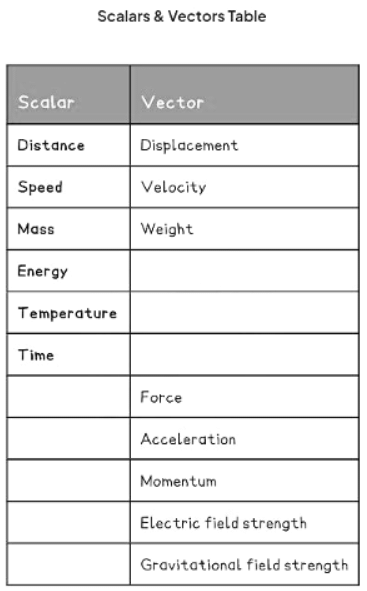Scalars & Vectors | Physics for GCSE/IGCSE - Year 11 PDF Download
Scalar & Vector Quantities
- All quantities can be one of two types: A scalar or A vector
Scalars
Scalars are measurements that solely possess a magnitude.
- Mass serves as an example of a scalar because it represents a quantity with magnitude alone, devoid of direction.
- Likewise, distance qualifies as a scalar because it is characterized by magnitude exclusively, lacking any directional component.
Vectors
- Vectors possess both magnitude and direction as defining characteristics.
- Velocity exemplifies a vector quantity because it incorporates both its magnitude and the direction of motion.
- When discussing the velocity of an object like a car, specifying both its speed and the direction of movement is essential.
- For instance, velocity could be expressed as 60 km per hour (magnitude) towards the west (direction).
- Distance is a scalar quantity as it solely indicates the extent or length between two points without considering direction.
- Displacement, however, not only measures distance but also specifies the direction of that distance.
- An example of displacement might be 100 km towards the north, illustrating its vector nature.
Examples of Scalars & Vectors
- The table below illustrates common examples of scalar and vector quantities.
- Some quantities, like distance and displacement, showcase similarities between scalar and vector aspects.

- Corresponding vectors and their scalar counterparts are aligned in the table where applicable
Using Scalars & Vectors
The example below demonstrates the process of discerning whether a quantity qualifies as a scalar or a vector.
Example: Blu is in charge of training junior astronauts. For one of his sessions, he would like to explain the difference between mass and weight. Suggest how Blu should explain the difference between mass and weight, using definitions of scalars and vectors in your answer.
Ans: Step 1: Review the definitions of scalar and vector quantities.
- Scalars possess magnitude alone.
- Vectors possess both magnitude and direction.
Step 2: Determine which quantity pertains solely to magnitude.
- For instance, mass is a scalar quantity as it solely concerns magnitude.
- For example, Blu could clarify to his junior astronauts that their mass remains constant even in outer space.
Step 3: Identify the quantity characterized by both magnitude and direction.
- Weight, being a force, is a vector quantity as it has both magnitude and direction.
- For instance, Blu might educate his junior astronauts that their weight, influenced by gravity, changes based on their distance from the Earth's center.
|
127 videos|148 docs|35 tests
|
FAQs on Scalars & Vectors - Physics for GCSE/IGCSE - Year 11
| 1. What is the difference between scalar and vector quantities? |  |
| 2. Can you provide examples of scalar and vector quantities? |  |
| 3. How can you use scalar and vector quantities in real-world applications? |  |
| 4. How are scalar and vector quantities utilized in physics equations? |  |
| 5. How can one determine if a physical quantity is scalar or vector in nature? |  |


















